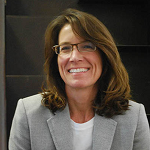
Dear COTE® Colleagues,
My final newsletter of the year is dedicated to the amazing COTE® advisory board, the incoming 2019 Chair Marsha Maytum and Mary Ann Lazarus, past chair. The best part of collaborating with this amazing group of people is the friendships I have made. We have accomplished so much this year and built a momentum that will continue for years to come. My hope is that we will continue to be linked with the depth of knowledge and expertise that exists within the AIA COTE® network of past, present and future members!
It is with a sense of urgency that I summarize my thoughts for you on the recently released Fourth National Climate Assessment (or the future as life as we know it), also elegantly summarized by The New York Times. This is not a political debate, although it will require political leadership. This is not a death sentence, although the lives and health of millions of Americans are at risk. Contrary to White House spokeswoman Lindsay Waters’s statement that this report “is largely based on the most extreme scenario,” this report comprehensively and consistently details two scenarios (the lower one “RCP4.5” and the higher one “RCP8.5”). Without significant reductions in greenhouse gas emissions and additional adaptation efforts we will see “substantial net damage to the US economy” and it is known that some degree of long-term change is locked in for centuries to come, such as global sea level.
Beyond the important efforts our profession has already initiated, there is an elephant in the room and it is one of scale. While the large-scale integration of renewable energy continues to grow globally, communities have been slow to address the stewardship of land use patterns, conservation, and reforestation. Managing our landscape more wisely could store enough carbon to offset up to 21 percent of current US greenhouse gas emissions and the large-scale changes that our profession can directly impact.
Our natural, built and social systems are interconnected and the climate change risks to these systems, ‘many of which span regional and national boundaries, is often greater than the sum of risks to individual sectors’. This is a paradigm shift in the way we think about the impacts of our individual actions and those of our professional organizations. We are all dependent on these systems in one way or another. Community health and the interdependence of systems will begin to take precedence over property rights. Growth boundaries, increased density and height, and innovative financial models to relocate or prevent building in high-risk locations or to retreat from at-risk coastal areas—are actions that must be addressed in our communities.
This is a call for citizen architects. We are a profession that can be the exemplar to address the future challenges of climate change. We can do this by leading by example, education and by working with political leaders (or becoming one!) and demonstrating how the natural and the built world can coexist while strengthening our social fabric.
Architects are by nature problem solvers and designers that put intention behind . We need to find a strong unwavering collective voice to be a part of the significant change that must be made. Yesterday is in the past. The future depends on what we do now.
 Angela Brooks, FAIA
Angela Brooks, FAIA
2018 Advisory Group Chair
AIA Committee on the Environment